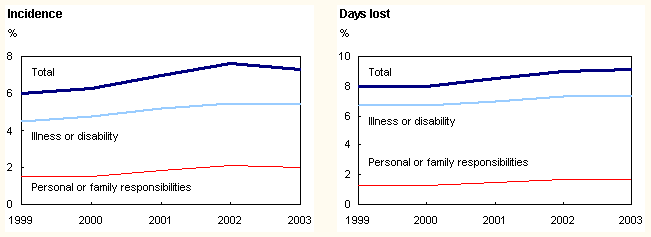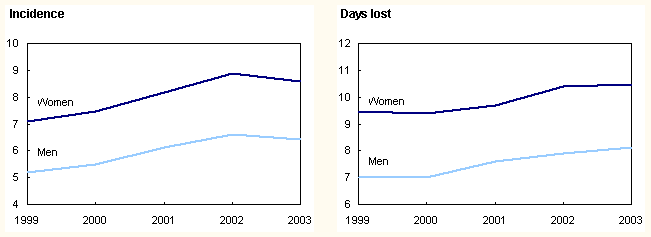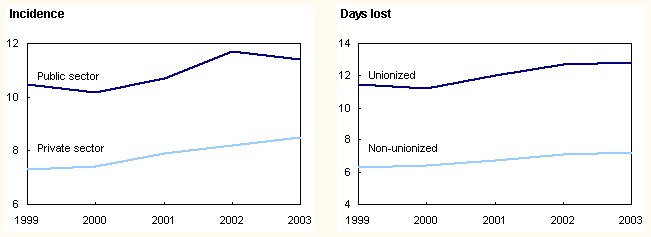
















 |
|
 |                |
Information identified as archived is provided for reference, research or recordkeeping purposes. It is not subject to the Government of Canada Web Standards and has not been altered or updated since it was archived. Please "contact us" to request a format other than those available.
| Work absence rates
2003 Analysis Work absence There are many kinds of absence. Some, such as annual vacations, are generally considered beneficial for both the organization and the employee. Since they are usually scheduled, their effect on the organization can be fairly easily absorbed; the same can be said of statutory holidays. Other absences, such as those caused by illness and family-related demands, are generally unavoidable, as are those due to inclement weather. ‘Absenteeism’—a term used to refer to absences that are avoidable, habitual and unscheduled—is a source of irritation to employers and co-workers. Such absences are disruptive to proper work scheduling and output, and costly to an organization and the economy as a whole. Although absenteeism is widely acknowledged to be a problem, it is not easy to quantify. The dividing line between avoidable and unavoidable is difficult to draw, and absenteeism generally masquerades as legitimate absence. The Labour Force Survey (LFS) can provide measures of time lost because of ‘personal reasons,’ that is, illness or disability, and personal or family responsibilities (see Data quality, concepts and methodology - Data Source ). However, within these categories, it is impossible to determine if an absence is avoidable or unscheduled. LFS data on absences for personal reasons can, however, be analyzed to identify patterns or trends that indicate the effect of absenteeism (see Data quality, concepts and methodology - Definitions ). Recent trends—1997 to 2003 Estimates from the Labour Force Survey reveal a steady rising trend in both work absence incidence and time lost for personal reasons (own illness or disability, and other personal and family demands) between 1997 and 2002. 1 Several factors accounted for the rising trend: notably, the aging of the workforce; the growing share of women in the workforce, especially mothers with young children; high stress among workers, 2and the increasing prevalence of generous sick and family-related leave at the workplace (Chart 1 ). In an average week in 1997, excluding women on maternity leave, about 5.5% (484,000) of all full-time employees holding one job were absent from work for all or part of the week for personal reasons. By 2002, the figure had risen to 7.6% (771,000) (Table 6 ). Total work time missed for these reasons also rose steadily, from 3.0% of the weekly scheduled work time in 1997 to 3.6% in 2002. Extrapolated over the full year, work time lost for personal reasons increased from the equivalent of 7.4 days per worker in 1997 to 9.0 days in 2002. Work absences due to own illness or disability as well as those due to other personal or family responsibilities witnessed continuous increases during the period. The steadily rising trend stalled in 2003. That year, the incidence fell to 7.3%, but the days lost per worker (9.1 days) were a shade higher than the year before, suggesting that absence durations in 2003 were generally longer. Whether this is the beginning of a new trend is too early to speculate. Variations in absence rates in 2003 Absence for personal reasons differs among various worker groups. Several factors are responsible; among the principal ones are working conditions (for example, the physical environment, degree of job stress, employer-employee relations, collective agreement provisions, work schedules); adequacy and affordability of community facilities such as child-care centres and public transportation; family circumstances, especially the presence of preschool children and other dependent family members; and physical health of the worker, a factor closely related to age. Measuring the effects of these and other contributing factors is not easy since many are not captured by the LFS. However, some insight is gained by examining personal absences in 2003 by selected demographic characteristics, occupation and industry, and other attributes such as union and job status. Demographic differences In 2003, excluding women on maternity leave, an estimated 7.3% (760,000) of full-time employees missed some work each week for personal reasons: 5.4% for own illness or disability, and 2.0% for personal or family responsibilities (Table 7-1 ). As a result, full-time employees lost about 3.6% of their work time each week. On average, each full-time employee lost 9.1 days over the year for personal reasons (about 7.4 for own illness or disability, and 1.7 for personal or family demands). In total, full-time employees missed an estimated 94.2 million workdays for personal reasons in 2003. On average, men working full time lost fewer days (8.1 or 6.6 for illness or disability plus 1.5 for personal or family demands) than women full-time employees (10.5 or 8.7 plus 1.9). The presence of preschool-aged children exerts a strong influence on work absences for personal or family responsibilities, especially for women. In such families, women employed full time lost an average of 4.5 days in 2003; men, 4.0 days. Workdays missed because of illness or disability tended to rise with age, from an average of 5.0 days for youth (15 to 19) to 10.8 for full-time employees aged 55 to 64. Industry and sector Work absence rates differ by sector (public or private) and industry, with almost all of the difference emanating from illness and disability absences (Table 8-1 ). Contributing factors include the nature and demands of the job, the male/female composition of the workforce, and the union density—the last being a strong determinant of the presence or lack of paid sick/family leave entitlements. Full-time employees in the public sector lost more work time in 2003 for personal reasons (about 11.4 days on average) than their private-sector counterparts (8.5 days). At the major industry level, the most workdays missed were by employees in health care and social assistance (12.8 days), transportation and warehousing (11.4), and public administration (10.7). The lowest averages were recorded by full-time workers in the professional, scientific and technical industry (5.3 days), and in agriculture (6.2). Occupation Contributing factors by occupational absence rates are similar to those for industry (Table 9-1 ). Again, as by industry, differences arise mainly from time lost due to illness or disability. The most days lost in 2003 were recorded for full-time employees in health occupations (13.0); occupations unique to production (11.1); and trades, transport and equipment operators (10.6). Workers in managerial jobs (5.2), natural and applied sciences (6.1), and culture and recreation (6.9) recorded the fewest days lost. Union coverage, job status, workplace size and job tenure Full-time workers who belonged to unions or were covered by collective agreements missed almost 80% more workdays on average in 2003 for personal reasons than their non-unionized counterparts (12.8 versus 7.2) (Table 10-1 ). Workers who considered their jobs to be permanent (and hence more likely to be unionized) lost more workdays (9.2) than those who said their jobs were not permanent (7.7). Days lost tended to rise with workplace size, increasing from a low of 7.5 in workplaces with fewer than 20 employees (firms more likely to have low union rates) to over 10.0 in workplaces with 100 or more (firms likely to have high union rates). Days lost tended to rise with job tenure, with almost all the differences arising from illness and disability. They rose from an average of 6.6 days among persons with tenure of up to one year to more than 10.0 days among those with nine or more years (the latter group likely being older). Province and CMA Work absence levels differed by geographic area (Table 11-1 ), with most of the variation again arising from illness or disability. Full-time employees in Quebec and Saskatchewan lost the most work time in 2003 (10.6 and 10.5 days). Those in Prince Edward Island (7.5) and Alberta (7.9) lost the least. Among the census metropolitan areas, workers in St. John’s, Saint John, Saguenay, Montréal, Sherbrooke, Gatineau, Thunder Bay, Regina, Saskatoon and Victoria lost the most workdays (an average of more than 10 days per full-time worker). Those in Greater Sudbury, Toronto, London and Calgary lost the least time (an average of less than 8.0 days per full-time worker). Chart 1

Chart 2

Chart 3

Chart 4

|
|
|
|